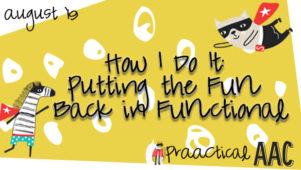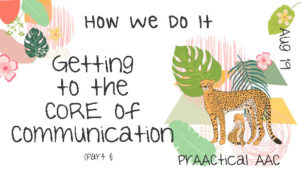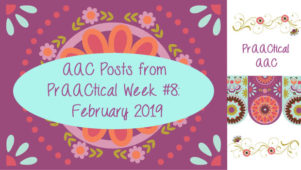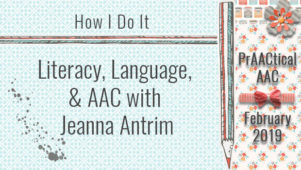How I Do It: Supporting Teachers of Students with AAC Needs

We couldn’t be happier to have a guest post by Jane Farrall for our How I Do It series. Jane has worked as a school and adult service based speech pathologist and literacy teacher. She has also worked as an assistive technology specialist and is currently working as an independent consultant in literacy, AAC and Assistive Technology. Jane has been working in the disability and assistive technology field for over 20 years. She has extensive practical experience in both AAC and in teaching children and adults with disabilities to acquire literacy. She has completed a Masters in Special Education focusing on literacy acquisition in children and adults without speech. Jane is a former Chairperson of AGOSCI (Australian Group on Severe Communication Impairment) and is the founder and organiser of the Big Mouth Camp, a camp for school aged students using speech generating devices and their families. You can get more information about Jane at her website www.janefarrall.com. We asked Jane to talk to us about how she supports educators who are teaching students with AAC needs.
How I Do It
Over the years that I have been a speech language pathologist, I’ve been privileged to work with lots of great teams in schools who are supporting students who use AAC. I have learned so much from teachers, aides, students who use AAC, parents, other speech pathologists, occupational therapists, physiotherapists and many others and am proud to say that I have worked with many students who have gone on to become very successful users of various AAC systems.
learned so much from teachers, aides, students who use AAC, parents, other speech pathologists, occupational therapists, physiotherapists and many others and am proud to say that I have worked with many students who have gone on to become very successful users of various AAC systems.
During the last two years I have been back in classrooms a lot more – I am usually brought in as a consultant to implement literacy and AAC goals for one or more students in the classroom. Each day I am in classrooms, I learn more about AAC and find it very exciting that there is always something new to learn about my favourite area of speech language pathology. Today, I want to share some of my learning with you and pass on my Top 5 tips for AAC in Classrooms. Many of the students I work with are just getting started with AAC so most of these tips apply to teams working with students who are just learning a low or high tech AAC system.
1. Modeling
Right about now you’re thinking “oh yeah – aided language stimulation”. And I am indeed talking about aided language stimulation. But I also mean modeling in terms of showing the team how they can use the student’s system to do aided language, in THEIR classroom, with THEIR students, for maximum language outcomes. Or, as I call it, “modeling how to use AAC for real reasons”.
Far too frequently, I go into classrooms and the student’s AAC system is sitting in a tub or on a shelf. It isn’t being used. If I ask about it I’m told things like “the speech pathologist dropped it off but we don’t know how to use it”. Or “we want to use it but….”. Or “we only use it at lunchtime”. Wherever possible, speech language pathologists need to make sure we go into the classroom and use the system for real reasons. We need to model doing aided language stimulation to the team, so that they can see how it works.
Modeling really helps the classroom team to understand that a student’s AAC system should be used expressively by us to help the student learn how to use it. Also, by fitting into the classroom routine and setting the AAC system up in whatever lesson they are doing, we are showing them that communication happens all day, every day. It isn’t a special activity that occurs twice a week – but something we can embed in the classroom at all times. If the class is doing guided reading, I can show them how to do aided language stimulation as part of guided reading – I can activate background knowledge, set the guided reading purpose and then take place in the discussion using the system. I make it clear that using the system isn’t something “extra” they have to make time to do, but that it’s just something that happens all the time. I had to do a lot of practice to be able to do this fluently – but that is also something I talk to the classroom team about and how they will probably need to practice too. As part of this I give them some small goals to start up – which leads me to my next point…..
2. Set Small Targets
Once I’ve modeled the use of the system, I give the team small targets to use throughout the whole school day. Helen Tainsh, who works at the Cerebral Palsy Education Centre, once told me about a list of small targets that she uses with families and I find that a list like this works well in classrooms too.
An example list of small targets would be:
a. Week 1 – figure out how you are going to have the communication book available all day
b. Week 2 – model “more”
c. Week 3 – continue to model “more” and add in “finished”
d. Week 3 – add in “like” and “don’t like”
e. Week 4 – extend like and don’t like to model giving an opinion
Etc
You can establish the list of goals based on each student, their language goals and their team. However, it’s really important that each of these goals happens multiple times through the day – and each of them is a small step building on the skills learned in the previous step. I’m don’t ever say “pull the system out and use it at lunchtime and then next week we’ll start using it when doing jigsaws”. I learned years ago that that leads to the communication book or system becoming part of the lunchtime program – and that it gets setup and packed up with lunch. Nor do I ever say “tomorrow, you need to start using this communication book to say everything”. Instead I am saying “Here is your target for the week – it’s something you can do all day, every day and I know you can do it”. It is important that everything we do, aims towards communication happening for real reasons, all day, every day but it’s also important that we don’t overwhelm people by expecting too much all at once.
3. Modeling
I know! I’m repeating myself by bringing up modeling again! But there is another important point to modeling that I wanted to make. As well as the reasons above, modeling also helps me to see how the system works practically. Sometimes I pick up a system, start using it for aided language stimulation, and then find it is impossible to use because a key page link is missing, or because the binding is too stiff and I can’t turn the pages! Or it could be impossible to use because the language is poorly selected or because it is too large or cumbersome to be manipulated in the physical space available. Using the system ourselves in the classroom helps us to make sure that it is actually possible – and that we aren’t asking the classroom team and student to do something impossible. It helps us to see what we might need to tweak to make it useable – or if we need to go back to the drawing board. I know this sounds simple – but I come across a surprisingly large number of systems that aren’t working because of reasons like these. And remember – if we can’t use the system to model language then it isn’t well designed. And if we can’t use the system to model language, then how can we expect the student to generate language with it?
4. Always work in the classroom
It is really important that we always work in the classroom. The only time I take a student out of the classroom is for a formal assessment. The rest of the time I want to work in the classroom and to show the team the student’s AAC and language goals can be met as part of what they do everyday. AAC is never something that happens in a special time or at a special place. I can work the language goals for students into most classroom sessions – and, of course, when you work in the classroom, it means that you can do more modeling 😉
5. Listen!
Listen to the team. Again, this seems like common sense but I know many classroom teams who feel that the student’s AAC system was developed without their input or that their feedback on the trial of a system wasn’t taken on board. Or they feel that their very valid issues with using the system haven’t been listened to. If we don’t listen, if we forge ahead because we are aiming for what we know is best for the student, then we end up with a situation where the classroom team has no ownership of the system and it is far less likely to be used. We need to listen to and address their concerns – and work through those concerns collaboratively. Only when we do this will we have the whole team working together on the AAC goals.
And that’s my top 5! I really hope that you find this list useful – even if you are doing all of these things already. I also hope that I have underscored the important of modeling for a range of reasons (and right now I’m just wondering how I can get the word modeling in one more time…..) And I would really love to hear from you about what you do to implement AAC in the classrooms you work in.
Filed under: PrAACtical Thinking
Tagged With: consultation, educators, How I Do It, Jane Farrall, teachers
This post was written by Carole Zangari





18 Comments
I could not agree more with this article!!
Thank you for writing and sharing it.
Thanks Ann! Glad you liked it 🙂
Cheers
Jane
As always Jane your information is great and so practical. I mainly work in early intervention these days and think the same ideas/tips can be used within childcare/kindergarten. Also I plan to adapt them slightly to use with families within their home as I think a lot of the issues again. Thanks for sharing your wonderful knowledge!
Thanks Nadine! Hope they work for you (although I’m sure you’re doing a lot of them already). Jane
Thanks for this. I think I should also be trying to do a lot of this at home with my son’s AAC device. Do you have any different kinds of tips for parents?
HI Melissa,
I think modelling is the most important thing you can do. If you can model with your child’s system then it is well designed – and if you can model with your child’s system then you can show them how to use it. The other thing I would say is that you need to figure out how you are going to take it everywhere with you. One of my favourite Gayle Porter quotes is “see child, see PODD”. But it really doesn’t matter which AAC system you are using so you could broaden that to “see child, see their AAC”.
Good luck with your child’s AAC system and I hope it goes well!
Jane
Thanks for sharing this information. As the parent in this equation it is sometimes a juggle with school, therapist and parent trying to work together without one party seemingly directly the other! I like the idea of starting the journey all together as equal supports to the child. The major hinderance here in Australia is money to support it all…..,its a costly exercise.
HI Bron, I actually live in Australia so I certainly understand that there are funding constraints at times – and that these vary greatly from state to state. But I generally find we can work around that if we work together as a team – and as you say sometimes that is difficult too!
I hope things work out well for you though – maybe sharing this and other resources from PrAACtical AAC with your team might help as well?
Cheers
Jane
Really good information. Especially like the emphasis on models. Let’s match up input and output!
Thanks John!!
Brilliant, as always, Jane! Thanks for sharing these tips…I’m off to share this link with the CCATT center page! 🙂
@Jeanne – thanks so much! You are always so kind 🙂
Fantastic, thank you! As a Speechie, I know all these things, but having them written out so clearly step by step has helped me focus. I particularly found the small steps very useful, as my little guy using AAC is the only one in his classroom and the teachers have not had much exposure to AAC before – so small weekly goals such as figuring out how they’ll have it available during the day is a great start. Thanks again 🙂
Hi Amanda, I’m so pleased it was helpful. And the small steps is really useful – they make a big difference in getting it all happening 🙂 Jane
Hi Jane,
I loved this article. I have taught in support classes for the last 13 years. I feel I was very blessed to have chosen teaching in special education.
This year is my first year I will have a class of students who are all non verbal. I am looking forward to learning about the new technology available to students to assist them in everyday communication! We have access to some assistive technology but not a great deal. I am just waiting on delivery of the all turn it spinner and a Beamer switch. I’m looking forward to implementing these tools as part of our “Yarning circle” each day and other activities through out the day. with our yarning circle, the students will use the switch to select the all turn it spinner who is here and the order of the greetings for each student. I want to introduce the students to using a big Mack switch to greet their peers with good morning, right from day one. I find your post and blog site very inspirational , thanks for sharing. So we can model to all students how to be effective communicators across all areas.
Excellent tips. Thanks for sharing
Thank you for this post! A great reminder..I will be applying these points in my work in New Zealand. Just wanted you to know that this info sharing is reaching slts all the way over here!
Thanks for that comment, Kylie. There are so many good pointers in this post. Would love to hear more about how this is working for you. 🙂